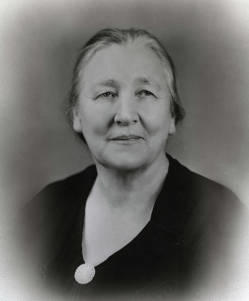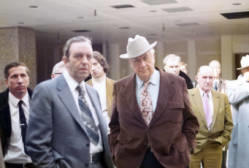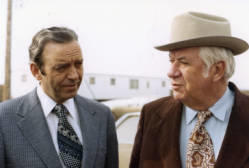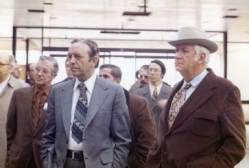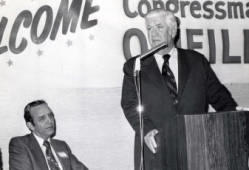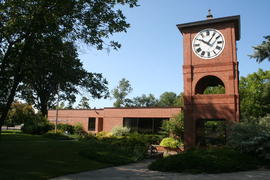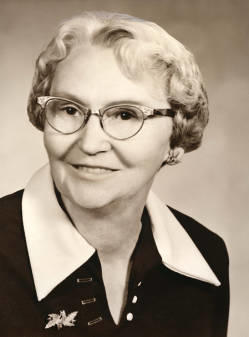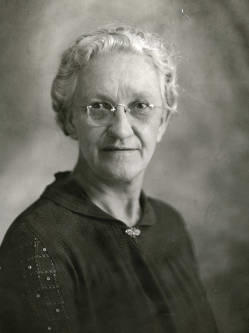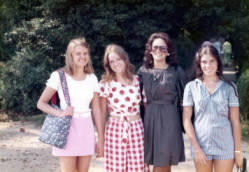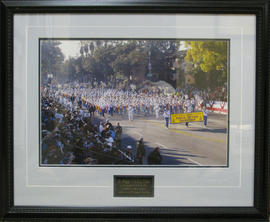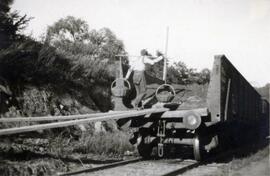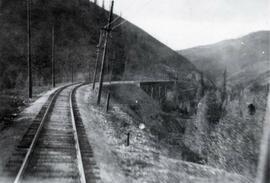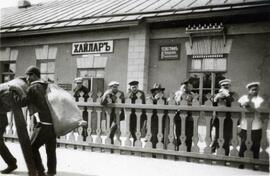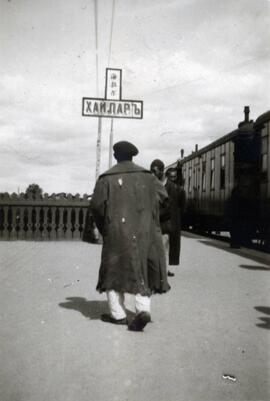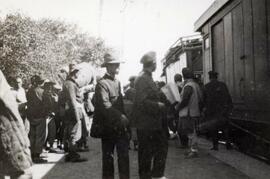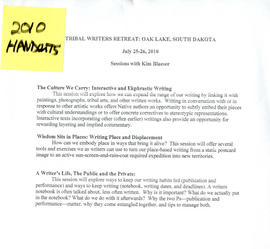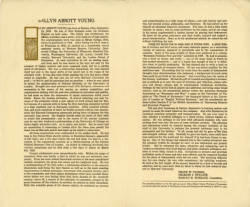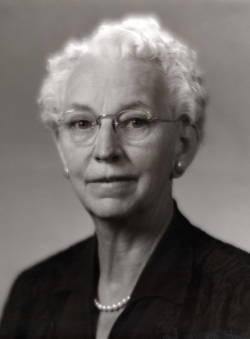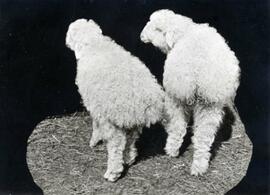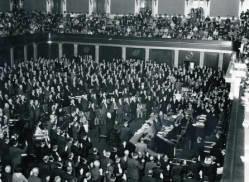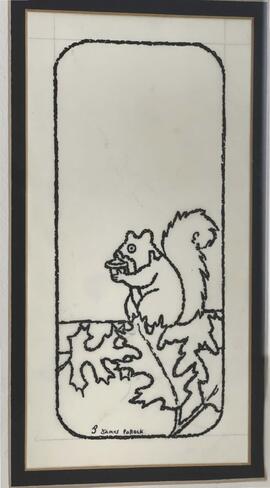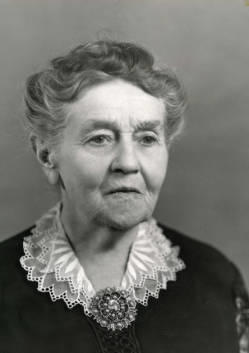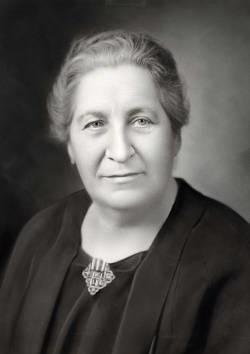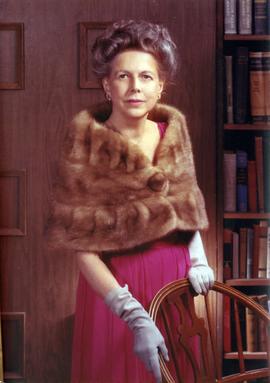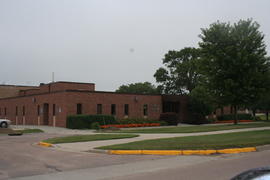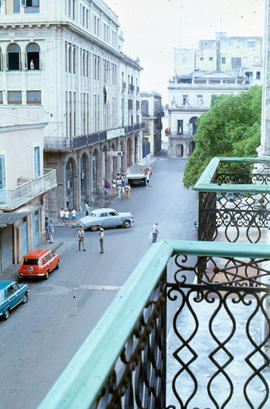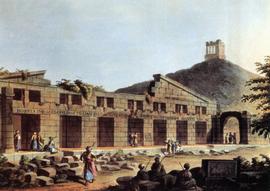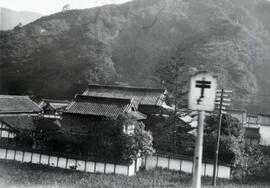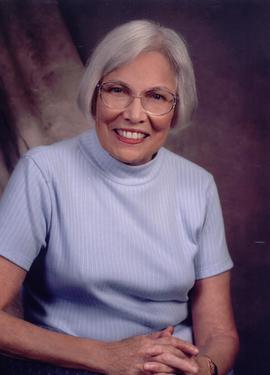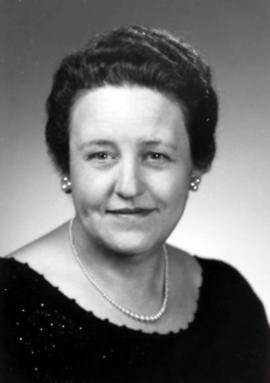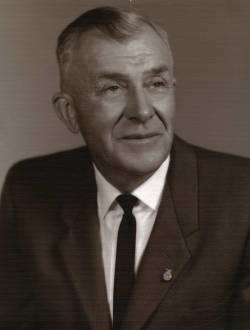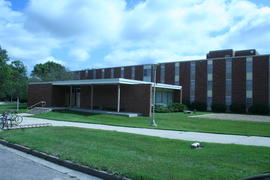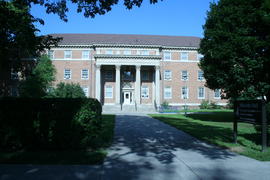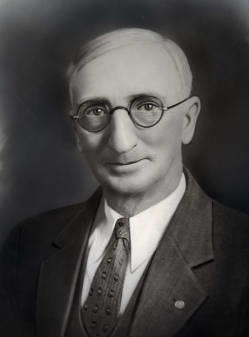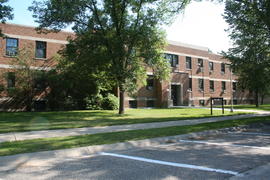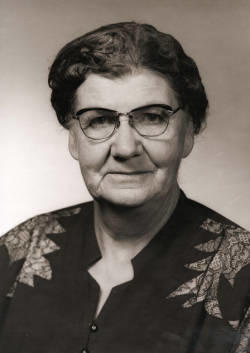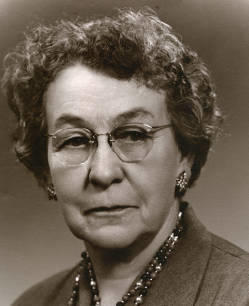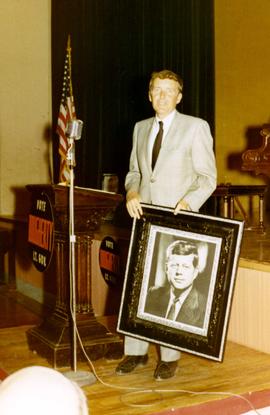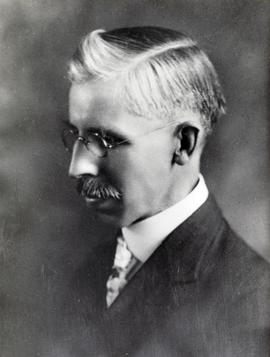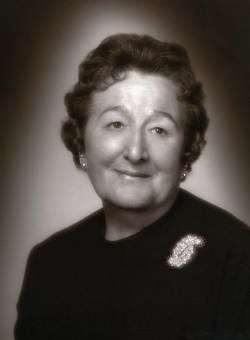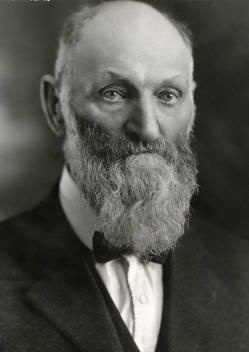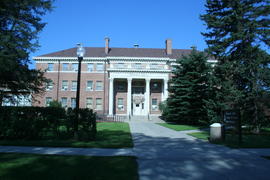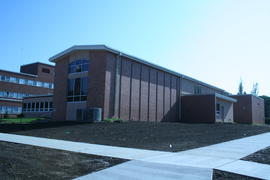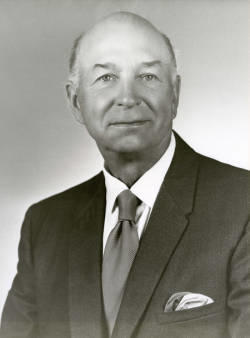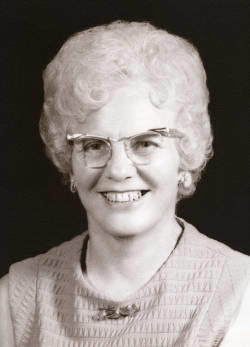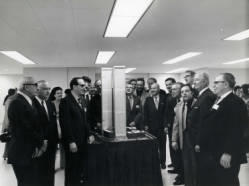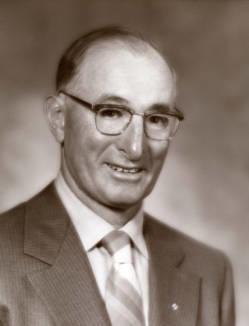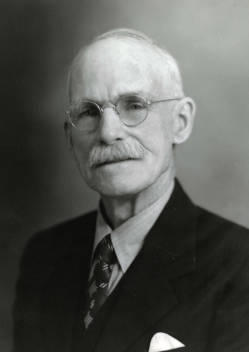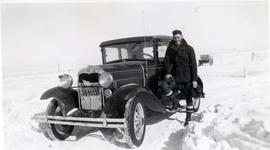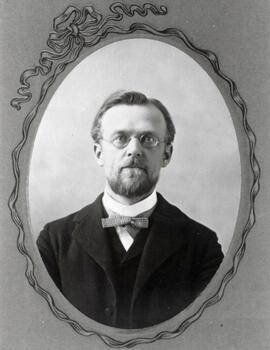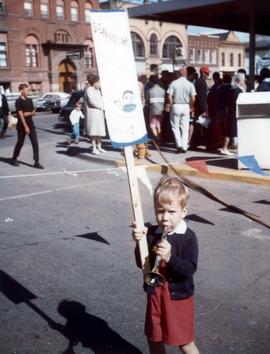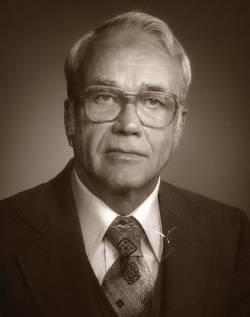Annie Thoreson from Dell Rapids, South Dakota was honored in 1937 as Eminent Homemaker by the Eminent Farmer and Homemaker Club at South Dakota State College.
Senator Tip O'Neill and Congressman Frank Denholm visit the Lincoln County Rural Water System site with others in South Dakota
Tip O'Neill and Frank Denholm visit the Lincoln County Rural Water System site with others in South Dakota.
Senator Tip O'Neill and Congressman Frank Denholm visit the Lincoln County Rural Water System site with others in South Dakota
Senator Tip O'Neill and Congressman Frank Denholm visit the Lincoln County Rural Water System site with others in South Dakota
Senator Tip O'Neill speaking at the Sioux Valley Minute Man meeting in Sioux Falls, South Dakota while Congressman Frank Denholm listens in the background
Delila Tompkins, wife of Elden Tompkins from Highmore, South Dakota, was honored in 1977 as Eminent Homemaker by South Dakota State University and the South Dakota Board of Regents.
Marie L. Torvik, wife of W.O. Torvik from Sisseton, South Dakota, was honored in 1938 as Eminent Homemaker by the Eminent Farmer and Homemaker Club at South Dakota State College.
Four women on a tour of Washington, D.C.
Man hauling dirt in baskets attached to a carrying pole on his shoulders, the dirt is being loaded on to a Trans-Siberian Railway train car near Saolin in northern China; written in pencil on the back: Saolin 1924 North China pear research
The organization that has made the Item available believes that the Item is in the Public Domain under the laws of the United States, but a determination was not made as to its copyright status under the copyright laws of other countries. The Item may not be in the Public Domain under the laws of other countries. Please refer to the organization that has made the Item available for more information.
Trans-Siberian Railway tracks through the mountains enroute to Saolin in northern China; written in pencil on the back: Railway Saolin 1924
People on the Trans-Siberian Railway platform by the train in Harbin, China; written in pencil on the back: Hailar 1924
Man walking on the Trans-Siberian Railway platform by the train in Harbin, China; written in pencil on the back: China
People standing on the platform by Trans-Siberian Railway in northern China; written in pencil on the back: On Siberian Railway 1924
List of sessions with Kim Blaeser for handouts at the Tribal Writer's Retreat at Oak Lake, South Dakota.
Manuscript printed in tribute to the life of Allyn Abbott Young by his colleagues and presented to Gertrude Stickney Young upon his death
Mrs. Bert Tupper from Junius, South Dakota was honored in 1956 as Eminent Homemaker by the Eminent Farmer and Homemaker Club at South Dakota State College.
Two Karakul fat tailed sheep were white long haired woolen sheep found in Turkistan that N.E. Hansen urged should be imported to the United States for dry hot regions like Arizona and New Mexico
Two men at a construction site in Cuba
Members of the United States Congress are taking the oath of office
Depicts a squirrel eating an acorn with leaves at its feet.
Illustration used in SD Digest Magazine.
Ella Vallery, wife of Peter P. Vallery from Midland, South Dakota, was honored in 1940 as Eminent Homemaker by the Eminent Farmer and Homemaker Club at South Dakota State College.
Lena Van Metre, wife of John E. Van Metre from Unityville, South Dakota, was honored in 1936 as Eminent Homemaker by the Eminent Farmer and Homemaker Club at South Dakota State College.
The Vera Way Marghab Papers is a comprehensive archive documenting the life and work of a woman who played a significant role in the luxury textile industry. The collection offers insight into her personal journey, from her early years in South Dakota to her time as a piano student in New York City, as well as her relationship with Emile Marghab through extensive correspondence. While much of the material is centered on her personal life, the collection also reflects her role in the linen industry as the driving force behind Marghab, Ltd. and Emile Marghab, Inc. The records highlight her meticulous nature, as she preserved extensive documentation on both her personal and professional endeavors. Given the interwoven nature of her life and career, the materials are arranged into distinct series that provide a structured approach to understanding her legacy.
The Business Series encompasses all aspects of the Marghab enterprises, both in New York and Madeira. It includes materials on the founding of the company, capturing the vision and strategy behind Emile and Vera’s business model, as well as its eventual dissolution. Correspondence reflects their relationships with artisans, business partners, and shop managers, while records on design illustrate Vera’s influence in maintaining the highest standards of quality. Trademark and copyright documents, including coded correspondence aimed at protecting proprietary designs, shed light on the competitive nature of the textile industry. One of the aspects of this series is the material related to the Mayflower cloth, a specially designed tablecloth for the 1957 Mayflower II voyage, which later became an exhibition piece at the World’s Fair in Australia. Administrative records from the New York and Madeira operations provide insight into the governance and structure of the business, including shareholder meetings, factory logistics, and high-profile engagements with diplomats and the U.S. Navy. Employee records detail the hiring process, disputes, and pension plans, while financial records illustrate the company’s fiscal health, including instances of embezzlement and tax matters. The marketing strategy developed by Vera is well-documented, with strict guidelines for Marghab Shops, controlled advertising, and policies that set the company apart from competitors. Records on the shops provide a glimpse into Vera’s selective approach, including her direct correspondence with store managers and evaluations of potential retail locations.
The Personal Series reflects Vera’s multifaceted life beyond her business endeavors. Materials include portraits and fabric samples that visually represent her legacy. Her commitment to philanthropy is evident in records of charitable donations and correspondence with organizations she supported. A large portion of the series consists of clippings and collected materials, which demonstrate her curiosity and engagement with various subjects. Personal correspondence includes letters to and from family, friends, and colleagues, some of which intersect with business matters. Financial records cover her personal wealth management, including investments, estate planning, and legal affairs. The series also includes materials on her life in Madeira, providing additional context to her time spent there beyond the confines of business. The establishment of the Marghab Gallery at the South Dakota Art Museum is well-documented, capturing her dedication to preserving the artistry of Marghab linens. Music played an important role in Vera’s early life, and materials on her musical education and performances offer insight into this passion. Personal writings, including reflections and philosophical musings, provide a more intimate look at her character and outlook on life.
Significant figures in Vera’s life are highlighted through correspondence and clippings, most notably her husband, Emile, and her immediate family. Her engagement with politics is documented through materials on political figures and organizations of interest to her. Rare book records illustrate her scholarly interests and her contributions to South Dakota State University’s library. Recognition for her contributions to the textile industry and beyond is captured in awards, articles, and documentation of a Marghab video project. Social engagements and affiliations with arts organizations further reflect her cultural involvement. Her extensive travels, both domestic and international, are documented in travel records, revealing her connections to a broader global network. Her deep ties to Watertown, South Dakota, are evident in materials related to her home, Wayland, and her properties on Lake Kampeska, as well as documentation on community events and restoration projects.
This collection is of exceptional significance, offering researchers a rich narrative of a woman who was both a cultural tastemaker and a shrewd business leader. It captures the evolution of a company that set new standards in luxury linens, the meticulous approach that defined its success, and the challenges it faced in an ever-changing economic and political landscape. Equally important, it provides a deeply personal portrait of Vera Way Marghab, allowing scholars to explore the intersections of entrepreneurship, artistry, and personal ambition. The collection stands as a valuable resource for those interested in business history, women’s history, textile design, and the legacy of craftsmanship that Marghab linens represent.
Marghab, Vera Way, 1900-1995Veterans of Foreign Wars color guard at a Memorial Day ceremony in Webster, South Dakota.
View from a balcony in Havana, Cuba
View of the Washington Monument in Washington, D.C. The Lincoln Memorial reflecting pool is in the foreground.
Views in the Ottoman empire, chiefly in Caramania, a part of Asia Minor hitherto unexplored : with some curious selections from the islands of Rhodes and Cyprus, and the celebrated cities of Corinth, Carthage, and Tripoli: from the original drawings in the possession of Sir R. Ainslie, taken during his embassy to Constantinople
London: R. Bowyer, 1803
Luigi Mayer was a watercolorist and draftsman of Italian origin. Mayer’s sketches have been cited as the most accurate representations of the Middle East prior to the nineteenth century.
Mayer, LuigiVillage nestled in the mountains by the Inland Sea in Japan; written in pencil on the back: Along Inland Sea, Japan 1924
The Virginia Driving Hawk Sneve Papers document the literary career, research, and advo-cacy of the acclaimed Lakota writer, educator, and historian. Spanning from the 1960s to the 2020s, the collection includes manuscripts, correspondence, research materials, and pub-lished works that reflect her dedication to Native American storytelling and cultural preservation. It offers a comprehensive look at her contributions to literature, education, and Indige-nous representation.
The Creative Writing series contains fiction and non-fiction works, including Completing the Circle, The Medicine Bag, Dancing Teepees, Standing Bear of the Ponca, and Sioux Women. Each work is accompanied by manuscripts, clippings, correspondence, research notes, print-er’s galleys, proofs, reviews, and scripts. Many manuscripts include editorial annotations and suggested revisions. The correspondence primarily consists of letters between Sneve and publishers, as well as heartfelt messages from schoolchildren, some with drawings, thanking her for her books and school visits. Research materials include notes, collected documents, and recorded interviews. A video adaptation of High Elk’s Treasure is also part of the collection.
The General series includes awards, speaking engagements, clippings, interviews, journals, and research materials. Correspondence features exchanges with publishing houses, Sena-tor Larry Pressler, and fellow writers such as Bob Karolevitz and Audrae Visser. Notably, the series contains an audio reel of an interview Sneve conducted with Harold Shunk, a Bureau of Indian Affairs superintendent. Other items include a 1901 class photograph and various teaching aids.
The Other Writings series highlights Sneve’s contributions beyond creative literature, includ-ing published articles, scripts for a South Dakota Public Radio series, Christian education re-sources for the Episcopal Church Center, newspaper editorials, studies for the Flandreau In-dian School, and a contribution to On the Wings of Peace, a compilation benefiting world peace organizations.
This collection serves as a significant resource for researchers, scholars, and educators stud-ying Indigenous literature, storytelling, and cultural history. It offers a valuable perspective on Native identity, advocacy, and representation, highlighting Sneve’s enduring impact on Native American literary and educational landscapes.
Sneve, Virginia Driving Hawk, 1933-This collection is composed of material from Volstorff's personal and professional life. Folders includes personal records retained during her tenure as Dean of Women, records from her work with campus organizations, planning documents, and personal information and correspondence. Also included are Volstorff's many speeches and writings, including research and drafts for her book, Winds of Change.
Volstorff, Vivian V. (Vivian Virginia), 1907-2002Correspondence from Charles Woodard regarding a mini grant that titles, "Voices From Along the River,' which focuses on the new perspective on Lewis and Clark.
This collection is composed of three diaries of J.M Aldrich during his tenure as a student at Dakota Agricultural College from 1885-1888. The diaries give an invaluable account on life as a student during the early years of the college. The diaries are separated into three volumes, one for each year Aldrich was a student at the college. Between 1930 and 1932, Aldrich made typewritten transcripts copied from his original diaries and included parenthetical comments for clarification. Each daily entry states the day and date, which are underlined, and relate Aldrich's daily activities. Most of the entries are trivial, recounting the activity of each day, but give an excellent portrayal of the atmosphere of Dakota Territory life in the 1880s. Topics included in the diaries range from accounts of his journeys between his home in Minnesota to Brookings to administrative upsets such as President George Lilley losing his position to Lewis McLouth.
This collection is composed of three diaries of J.M Aldrich during his tenure as a student at Dakota Agricultural College from 1885-1888. The diaries give an invaluable account on life as a student during the early years of the college. The diaries are separated into three volumes, one for each year Aldrich was a student at the college. Between 1930 and 1932, Aldrich made typewritten transcripts copied from his original diaries and included parenthetical comments for clarification. Each daily entry states the day and date, which are underlined, and relate Aldrich's daily activities. Most of the entries are trivial, recounting the activity of each day, but give an excellent portrayal of the atmosphere of Dakota Territory life in the 1880s. Topics included in the diaries range from accounts of his journeys between his home in Minnesota to Brookings to administrative upsets such as President George Lilley losing his position to Lewis McLouth.
This collection is composed of three diaries of J.M Aldrich during his tenure as a student at Dakota Agricultural College from 1885-1888. The diaries give an invaluable account on life as a student during the early years of the college. The diaries are separated into three volumes, one for each year Aldrich was a student at the college. Between 1930 and 1932, Aldrich made typewritten transcripts copied from his original diaries and included parenthetical comments for clarification. Each daily entry states the day and date, which are underlined, and relate Aldrich's daily activities. Most of the entries are trivial, recounting the activity of each day, but give an excellent portrayal of the atmosphere of Dakota Territory life in the 1880s. Topics included in the diaries range from accounts of his journeys between his home in Minnesota to Brookings to administrative upsets such as President George Lilley losing his position to Lewis McLouth.
Preliminary poster for 'Walk for Justice,' a spiritual walk from Brookings, South Dakota to Canton, South Dakota honor of all women who have lost their lives to sexual violence. The walk ends at the Hiawatha Insane Asylum site in Canton.
Percy J. Wallace from Britton, South Dakota was honored in 1962 as Eminent Farmer by the Eminent Farmer and Homemaker Club at South Dakota State College.
Titus C. Wentz from Bath, South Dakota was honored in 1933 as Eminent Farmer by the Eminent Farmer and Homemaker Club at South Dakota State College.
Niesje Wiersma, wife of John Wiersma from Volga, South Dakota, was honored in 1955 as Eminent Homemaker by the Eminent Farmer and Homemaker Club at South Dakota State College.
Ethel Wieting, wife of Charles Wieting from Tulare, South Dakota, was honored in 1956 as Eminent Homemaker by the Eminent Farmer and Homemaker Club at South Dakota State College.
William Dougherty, Richard Kneip's running mate in the 1970 election, isstanding next to a podium holding a framed picture of John Kennedy at a campaign event. The podium has a sign attached to the front saying Vote Dougherty Lt. Governor.
This collection is composed mainly of Powers' notes and materials he wrote about his history of the college. For the most part, these are draft materials. Also included are some correspondence and some totally unrelated material. This material includes notes about the foundation of the Brookings Public Library, and notes on the World Disarmament Committee, including a petition against conscription signed by many university faculty.
Powers, William H. (William Howard) 1868-1936Mrs. Allan E. Wilson from Mansfield, South Dakota was honored in 1964 as Eminent Homemaker by the Eminent Farmer and Homemaker Club at South Dakota State College.
Andrew J. Wimple from Beresford, South Dakota was honored in 1927 as Eminent Farmer by the Eminent Farmer and Homemaker Club at South Dakota State College.
Citation and biography of Andrew J. Wimple from Beresford, South Dakota who was honored in 1927 as Eminent Farmer by the Eminent Farmer and Homemaker Club at South Dakota State College
Harry Witt from Butler, South Dakota was honored in 1972 as Eminent Farmer by South Dakota State University and the South Dakota Board of Regents.
Selma Woods, wife of Monroe Woods from Aurora County, South Dakota, was honored in 1973 as Eminent Homemaker by South Dakota State University and the South Dakota Board of Regents.
Congressman Frank Denholm (center to the right of the towers in a light color jacket) with a large group of people looking at a model of the World Trade Center building
Warren L Wright from Rowena, South Dakota was honored in 1971 as Eminent Farmer by South Dakota State University and the South Dakota Board of Regents.
W.F. (Will) Wyatt from Hot Springs, South Dakota was honored in 1941 as Eminent Farmer by the Eminent Farmer and Homemaker Club at South Dakota State College.
Young Frank Denholm standing by car in winter.
Portrait of a young N.E. Hansen wearing a bow tie and a dark jacket
Little boy standing on a street with a Denholm sign in one hand and a toy trumpet in the other hand.
Leslie Zeller from Vermillion, South Dakota was honored in 1979 as Eminent Farmer by South Dakota State University and the South Dakota Board of Regents.

